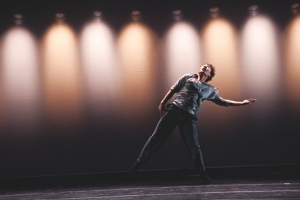A Dance Review by Eury Chang
Published in 16.1
Show: Under the Skin
Companies: Wen Wei Dance and Beijing Modern Dance Company
Date: March 11 and 12, 2011
Presented as part of Vancouver’s large-scale DanceHouse series, Under the Skin was met with great anticipation and curiosity. The evening was essentially comprised of two related works: Journey to the East, choreographed by Gao Yanjinzi, Artistic Director of the Beijing Modern Dance Company (aka BMDC); and In Transition, choreographed by Wen Wei Wang, Artistic Director of Vancouver-based Wen Wei Dance. Under the leadership of Gao Yanjinzi, BMDC has slowly become one of China’s signature cultural ambassadors. Gao herself worked intensively with Vancouver dancers in her hometown of Beijing, China and also in Alberta at The Banff Centre. For Vancouver dancers Jung-Ah Chung, Josh Martin, Scott Augustine, Karissa Barry, Tiffany Tregarthen and David Raymond, and Beijing dancers Chaoke, Gu Jiani, Lai Weiyi, Liu Mingda, Sharina, and Xu Zhi, the whole project was an intense experience in cross-cultural and artistic collaboration. In the studio, the architect of the project, Wen Wei Wang, had to act as translator, literally showing and describing Gao’s choreographic style and intentions to his Vancouver-based dancers. Similarly, the dancers of the Beijing Modern Dance Company had to be encouraged, even cajoled, to find their own voices within the choreographic structures developed by Wang.
PART ONE
At first, we see semi-naked bodies behind screens. The Beijing dancers look outwards, facing the audience, across what seems to be a wide expanse of time, distance, and space. The Vancouver dancers have their backs to the audience, completing the image of a mirrored reflection of humanity. The result is a simple but effective scenario: us watching Beijing dancers, who in turn, are watching Vancouver dancers. At times, the dancers place their feet carefully; other times, the legs seem unsure of themselves, like those of scurvy-laden sailors. Dancers become characters—weathered travellers bound by hope and faith. Sounds of wind and water echo through the theatre. The water and blood that runs through the veins creates visible ripples on the flesh: a nuanced ebb and flow of physical sequences. Is the shore near? Are we crossing the ocean on a boat, surrounded by fish and birds? The duet between Josh Martin and Jung-Ah Chung seems to represent this possibility; the duet is simply sublime, intimate and arresting. Like a seaweed floating on the ocean’s surface, Chung changes shape while Martin carries his companion’s weight; the contemporary pas de deux reveals a crouching tiger on man’s shoulder, a splitting scissor as legs part, sinewy stretchy muscle, and paddling arms. Scott Augustine is also a major contribution to the evening’s work; even his relatively compact frame provides us with controlled bursts of energy and elegant lines normally associated with long-limbed dancers.
The musical by Dou Wei is almost haunting; in addition to sounds of animals and wind and waves, the syncopated drum rhythms create a monstrous energy, one that conjures images of opening heavenly gates and impending demise or change. The dancers roll on the ground in rage, swaying side-to-side in unison. Chimes and gongs are heard. As a climax, all 12 dancers are onstage, distinguished and separated only by different clothing. Their arms are outstretched like tree branches, a metaphor for wanting to connect and walk in someone else’s shoes. At the end of the work, the Vancouver dancers are behind the screen, watching the audience across the expanse of time, distance and space. They have arrived on the other side of the river, now face to face with another culture.
PART TWO
After the intermission, the dancers of the BMDC perform in a work entitled In Transition, choreographed by Wen Wei Wang. Sitting in the theatre, audience members are like old friends waiting for a reunion to happen; the anticipation and curiosity in the theatre is palpable. The work begins with a short film, created by David Raymond, a dancer with Wen Wei Dance. Shown on the screen above the stage are two white ducks waddling through the streets of China; they are interacting with their human counterparts. A few seconds later, we see an image of a man cutting a roast duck, carefully slicing the crispy skin off the top of the piece of meat. Then, images of the two white ducks in the street appear again, only to be juxtaposed with images of the same butcher cutting a piece of juicy, roast duck. Audience members accustomed to seeing barbeque meat hanging in Chinatown butcher shops are privy to the inside joke. The film is part reflection and part commentary on cultural habits, but in the context of the show, also provides a remotely crude metaphor for the “cutting-up” of identity in today’s trans-national world.
